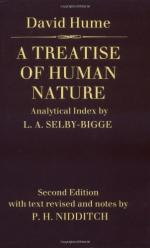To begin with the first case; it is evident, that when only two luminous bodies appear to the eye, we can perceive, whether they be conjoined or separate: whether they be separated by a great or small distance; and if this distance varies, we can perceive its increase or diminution, with the motion of the bodies. But as the distance is not in this case any thing coloured or visible, it may be thought that there is here a vacuum or pure extension, not only intelligible to the mind, but obvious to the very senses.
This is our natural and most familiar way of thinking; but which we shall learn to correct by a little reflection. We may observe, that when two bodies present themselves, where there was formerly an entire darkness, the only change, that is discoverable, is in the appearance of these two objects, and that all the rest continues to be as before, a perfect negation of light, and of every coloured or visible object. This is not only true of what may be said to be remote from these bodies, but also of the very distance; which is interposed betwixt them; that being nothing but darkness, or the negation of light; without parts, without composition, invariable and indivisible. Now since this distance causes no perception different from what a blind man receives from his eyes, or what is conveyed to us in the darkest night, it must partake of the same properties: And as blindness and darkness afford us no ideas of extension, it is impossible that the dark and undistinguishable distance betwixt two bodies can ever produce that idea.
The sole difference betwixt an absolute darkness and the appearance of two or more visible luminous objects consists, as I said, in the objects themselves, and in the manner they affect our senses. The angles, which the rays of light flowing from them, form with each other; the motion that is required in the eye, in its passage from one to the other; and the different parts of the organs, which are affected by them; these produce the only perceptions, from which we can judge of the distance. But as these perceptions are each of them simple and indivisible, they can never give us the idea of extension.
We may illustrate this by considering the sense of feeling, and the imaginary distance or interval interposed betwixt tangible or solid objects. I suppose two cases, viz. that of a man supported in the air, and moving his limbs to and fro, without meeting any thing tangible; and that of a man, who feeling something tangible, leaves it, and after a motion, of which he is sensible, perceives another tangible object; and I then ask, wherein consists the difference betwixt these two cases? No one will make any scruple to affirm, that it consists meerly in the perceiving those objects, and that the sensation, which arises from the motion, is in both cases the same: And as that sensation is not capable of conveying to us an idea of extension, when unaccompanyed with some other perception, it can no more give us that idea, when mixed with the impressions of tangible objects; since that mixture produces no alteration upon it.




